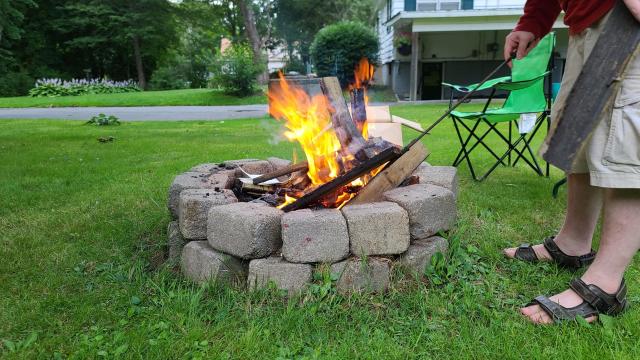A fire pit is a welcoming addition to any backyard. It can become a central gathering point and can extend the warm season by keeping you cosy from spring through fall. Building a fire pit yourself is a tempting project, but there are some things you should consider before taking this on — for your safety and your neighbours’.
Check out the local rules first
The first thing to do when installing a fire pit is read up on local ordinances or any rules governing outdoor burns that might affect your plans. In addition to checking in with your local planning office, you should also look at your deed. Once you’ve cleared your fire pit with authorities, you can choose your materials.
Choose materials for your fire pit
For the interior of your fire pit, you should ideally use fire brick, because it is insulating. Fire brick comes in a variety of colours and even shapes, but this isn’t the part that people will see the most of, so don’t worry about that too much. Choose your fire brick for safety, not aesthetics.
For the exterior of the pit and the area around it, any type of fire-resistant stone is fine. You’ll need enough fire brick to make a pit that’s 36 to 44 inches across and about 12 to 24 inches tall. This will give you a good place to prop your feet up and be a barrier against some sparks. You’ll want enough material for the exterior of your pit so that you can have a fire resistant area around the pit that’s at least three feet wide. For added safety, you should also consider a screen cover to keep sparks to a minimum.
Another add-on that can help keep your fire pit safe and functional is a steel ring to keep your fire brick from drying out too much. This can extend the life of your fire pit and make it more sturdy, too. They come in a variety of shapes, so you can choose one that best fits your space.
Find a good location and set up your pit
Once you’ve chosen your materials, you need to pick a place for your fire pit to go. Think about wind, flammable materials, and space for seating. Select a location that has some wind cover, consider the distance between the pit location and anything that can catch on fire — like your trees or your house — and make sure you have enough room for seats. The seats need a bit of space between them and the pit, but they’re also the whole point of doing this.
With all that in mind, under a tree or a patio overhang isn’t the best place to put your fire pit. Other than that, you should choose a place that’s well-suited for company and inviting for spending time outside.
Digging a hole for your fire pit is optional, but it is important to clear any grass or weeds from the area. If you choose a flat spot, you can build your fire pit structure straight up from the ground. If you choose to dig a hole for your pit, call 811 to make sure there aren’t any utilities in your way. Then, using a shovel, dig a hole the size and shape that you want the opening of your fire pit to be, plus the thickness of your fire bricks, about 12 to 24 inches deep. If you’re using a steel ring, you can use that as a guide for the approximate dimensions of the hole. Finally, pack down the soil so you have a good interior surface to lay your fire bricks.
Alternatives to building your own fire pit
An alternative to a wood-burning fire pit is a propane burning fire pit. You can get one of these as a kit or pre-built, and it’s a good option if you don’t want to do a lot of building and stone hauling. These can be safer if your area is windy because they don’t cause sparks. Also, you can use pretty, decorative rocks or recycled glass as a base for them. Another alternative to an DIY fire pit is a portable one that can be placed on a slab. These are simpler to use and shouldn’t require permits. You’ll still need to remove grass and any other flammable material from around where you plan to put your fire pit.
Safety first and last
Safety equipment is definitely important to keep on hand when you’re using your fire pit. Having a fire extinguisher that’s appropriate for the type of fuel you are using and a hose hooked up ready to go just in case is a must. It’s also important to keep in mind weather or drought conditions. Check local burn bans before lighting a fire to keep yourself safe.

Leave a Reply
You must be logged in to post a comment.